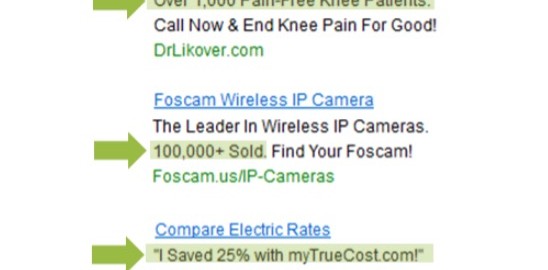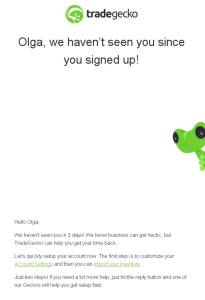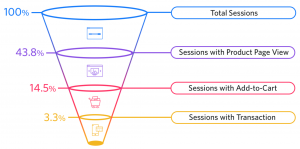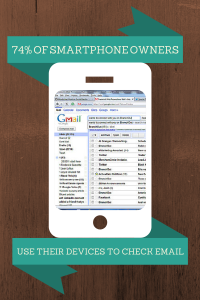It may sound sleazy to consider persuading user perceptions, but PPC persuasion need not involve manipulation to increase PPC ad clicks.
When you start a PPC ad campaign, you want to draw customers to your website, product, mailing list, or another marketing goal frequently and repeatedly.
But how do you persuade users into believing that what you have to offer is superior to your competitors’ offerings? You persuade them by targeting their pre-existing needs and desires. You present them with a solution – a valuable, useful, emotionally charged solution.

Present a valuable, useful, emotionally charged solution!
But that’s not all.
Persuasion isn’t about changing the way a person thinks. According to research scientist, Jay A. Conger, it’s “instead a process of learning from others and negotiating a shared solution.” To increase PPC ad clicks, you must take the time to understand your customers as dynamic individuals.
Next, you’ll want to use copy to transition these individuals from pain points or dull states of being to a more desirable outcome. You do this by appealing to the range of emotions connected to whatever situation frustrates them.
Since PPC campaigns aren’t isolated marketing tools, we’ll first discuss copy in general before applying this approach to increasing PPC ad clicks.
Emotional Perception
Emotions heavily influence buying decisions. Marketers suggest that only 20% of buying decisions are made according to logic. And when choices are made, particularly in response to advertisements, they’re done in an instant. Therefore, individuals make emotional decisions driven by the moment.
For example, one marketing company supplied consultation services to a company that retails infant bathtubs.
The two primary features of the infant tub are that it’s soft, making it comfortable for the baby, and it’s safe, making parents feel confident that they can safely bathe their baby.
If their PPC copy read, “Buy the nation’s softest, safest bathtub for your new baby!” they’d simply be describing benefits of buying an infant bathtub.
But if their copy instead read, “Bath time with your newborn doesn’t have to be a scary, frustrating experience“, parents would instantly recall memories of bath time with their baby.
Most parents and caregivers have experienced those near-miss moments when their soapy baby nearly slides out of their arms while cleaning them in an unpadded tub.
A parent searching for a replacement tub would identify with the emotions from the second copy example above because they’d feel fearful of potentially dropping their child in a fairly hard tub. A parent would feel hopeful after reading, “Bath time with your newborn doesn’t have to be a scary, frustrating experience.”
Emotional Targeting
When you effectively market to your customers, they become individuals who identify with the intended outcomes of your product or service. This makes what you have to offer a shared experience, not a business to consumer transaction.
In a Pagewiz podcast episode on emotional targeting, Talia Wolf amplifies the emotional aspect of marketing. Instead of solely focusing on behavioral targeting – which hones in on the behavioral patterns of customers, she suggests a holistic approach to writing copy. Talia stated that, in short, emotional targeting looks at the emotion behind the behavior.
When you’re writing emotionally targeted copy, you not only consider who your customer is, but you determine how to quickly communicate a marketing message that triggers an emotional connection.
You have just three seconds to use PPC ad copy to stir a connection that inspires action – regardless of how long a conversion takes.
One study appealed to individuals looking for their perfect match in a mate. Anyone can create a profile on a dating website, but that doesn’t mean they’ll find a significant other.
Using emotional targeting, new users to this dating site were invited to not only join a new dating site but find their perfect mate on that website.
 Users were invited to not only join, but also find their perfect mate
Users were invited to not only join, but also find their perfect mate
The second half of their copy offered the emotional appeal. The company used images to communicate that users couldn’t only find their perfect mate but also have a large pool from which to select their mate.
This value proposition led to 38% more signups and a 304% increase in paying users on this dating website.
Lastly, consider the type of purchase your target audience members are making. The purchase type may fall into one of these categories: impulse purchase, routine purchase, or a major new purchase. Here’s an explanation of each:
- Impulse purchase – Impulse buys are heat of the moment purchases. Typically, this purchase is of a last minute, low-priced item in conjunction with other items that were chosen with more intention. An online example could be adding a bag of candy to your cart after purchasing a book on Amazon. Or regarding services, adding an eBook to your cart when your primary goal was to order coaching services.
- Routine purchase – Routine purchases are made on a regular basis – daily, weekly, monthly, or yearly. Price comparisons are rarely made, and rarely is new research conducted, as individuals making routine purchases are largely brand loyal. A prime example of a routine purchase for an online business owner is a domain renewal. Whether you renew your domain yearly or every five to ten years, it’s atypical to hunt for an alternative company through which to renew your domain – unless you’ve had an awful experience with your current provider.
- Major new purchase – Major new purchases might require a longer decision-making process because the item to be purchased is either more expensive or extremely important. Membership on a dating website is a great example of a major new purchase. It’s a major life decision that might involve extensive research, polling family members, seeking the opinions of friends, and reading about others’ experiences with the website before joining.
Taking purchase type into consideration is another aspect of getting to know the individuals you market to before asking them to make a purchase, join your email list, or become a member of your online group.
Value Perception Influences PPC Ad Clicks and Effectiveness
Consider how you would feel receiving your own product or service, and then incorporate those feelings into your PPC ad copy.
The impact of emotion is especially striking when referring to social pay-per-click ads. In a study conducted by OkDork and Buzzsumo, awe, laughter, amusement, and joy led to more social shares than negative emotions, like sadness and anger.
It’s value perception, not a focus on persuasion that can lead to more clicks. When you put yourself in the place of your audience members, you can more easily craft PPC campaign copy they can identify with, and then act upon.
Instead of overselling, accurately describe the value of your product or service in a way that will hold your audience’s interest.
Crafting Emotionally Driven Click Campaigns
With all the previous points in mind, let’s consider ways to use emotionally amplified language to contribute to more clicks.
When selecting persuasive phrases for your PPC campaigns, keep images of your customer as an individual at the forefront of your mind.
Also, note the frame of mind customers are in before clicking on your PPC advertisement – whether it’s posted in a search engine or on social media. Individuals seek solutions from previously unknown products and services when they’re dissatisfied with their current solution.
Identifying this pain point guides your choice of words and positions you to make a promise that gets the click.
Here are some ways to incorporate emotionally driven language into your PPC campaigns:
Use Action Verbs
Dynamic verbs can significantly increase ad clicks. In one AdWords PPC campaign, including the verb increase in the headline led to 150% more clicks.

Action verbs act as an invitation. There’s an immediate emotional reward that comes with replying to that invitation that causes individuals to click through to your ad.
- Hurry
- Fulfill
- Uplift
- Conquer
- Dare
- Forbid
For example, a PPC ad heading might read, “Conquer your fear of flying,” “Take a skydiving course with trained professionals,” or “Hurry in for this seasonal beverage.”
With the latter example, the cost is rarely a factor because seasonal offerings present the concept of scarcity.
 Seasonal offerings present the concept of scarcity
Seasonal offerings present the concept of scarcity
The fear of not having a specific beverage when it’s offered seasonally – for example, the Shamrock shake from McDonald’s or the Pumpkin Spice Latte (PSL) from Starbucks – makes the cost of no consequence.
The value of consuming the drink for one (Shamrock shake) or two months (PSL) out of the year far exceeds the attributed monetary worth.
Use Adjectives
Adjectives are descriptions of the words that follow them.
Although there isn’t one specific resource that teaches you how to use dynamic language, Words the Sell: More than 6,000 Entries to Help You Promote Your Products, Services, and Ideas by Richard Bayan is a helpful guide.
He breaks words and phrases up into various categories, like Clinchers, Grabbers, and Descriptions & Benefits, and then groups them even further.
For example, some appealing words under “Descriptions and Benefits” are:
- Charming
- Cozy
- Exquisite
- Yummy
- Memorable
- Vibrant
How would a PPC ad headline with descriptive words look?
- “Make this charming cottage your new home…”
- “Order exquisite Italian leather shoes…”
- “Yummy artisan cupcakes await…”
Descriptive words are enticing. They paint a picture for individuals who can imagine themselves wearing your clothes, completing your eCourses, or otherwise changing their lives for the better. Every call to action is a call to a solution.
Use Social Proof
As social beings, people like what others like even if they don’t know one another.
This is why reading product reviews and service testimonials has such an impact on buying decisions. If others like a specific product or service, the individual who views your advert might conclude that they’ll have a positive experience as well.
If your product has a high star rating, or if your website appears to be popular, users will gravitate towards your offerings based on social proof.
Incorporating social proof into your PPC copy helps individuals:
- Let their guard down
- Feel as though they’re one of many making the same choice
- Feel justified when experts make or recommend the same choice
Here are a few examples of PPC ads using social proof in their copy:

When a Houston orthopedist helps rid over 1,000 patients of knee pain, that ad will undoubtedly get lots of clicks. If others are saving on their energy bill, you better believe those who view that ad will want to do the same.
Using social proof communicates value to potential customers without the business owner having to “toot his own horn.”
Using social proof language in PPC copy eliminates the need to “prove” the worth of your product or service because past customers communicate the worth for you. Your only job then is to provide the value others speak so highly of.
Exceeding Value Perceptions
Craftiness won’t lead to increased PPC clicks, but choosing emotionally laden words that describe added value to your customers, will.
Persuading user perceptions is all about getting to know your audiences’ needs and pains, and then offering a solution that not only gets the click but presents your audience members with a specific, value-filled solution that’s emotionally appealing.
Words that Sell author Richard Bayan wrote, “An advertising copywriter uses words as tools to persuade and motivate an audience. You persuade your readers that you have something valuable to offer; you motivate them to acquire it for themselves. This is the essence of effective advertising, whether you opt for the hard sell or subliminal suggestion.”
Which persuasion methods do you use to increase PPC ad clicks? Have you considered the emotional aspect of persuading user perceptions? Let us know what’s worked and what hasn’t worked in the comments section.
Digital & Social Articles on Business 2 Community(44)








